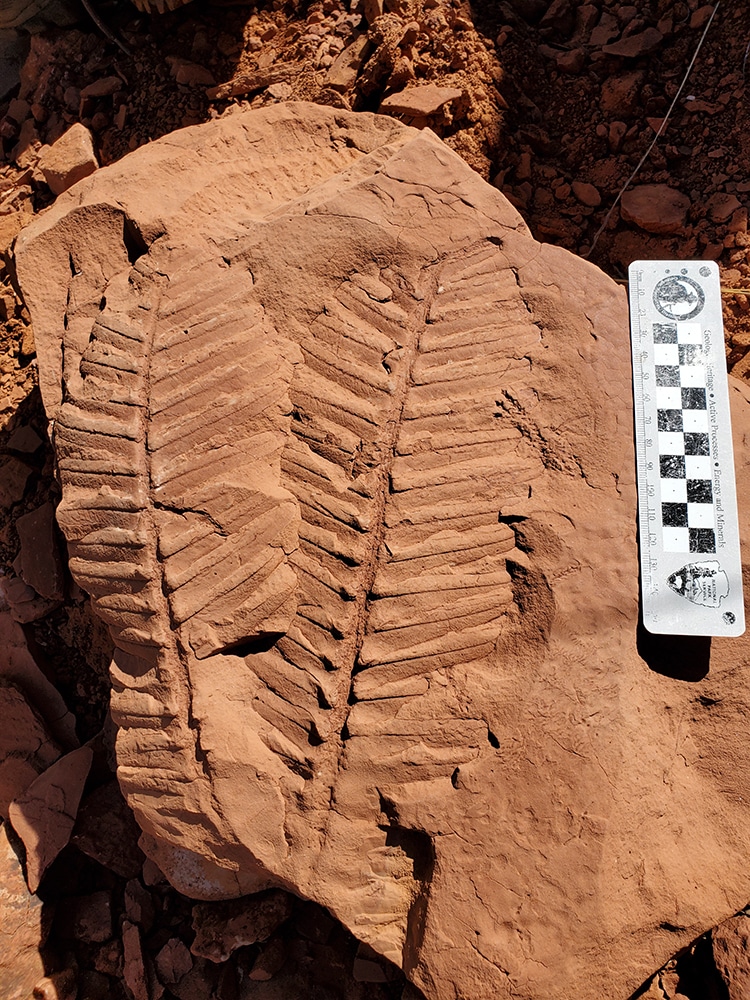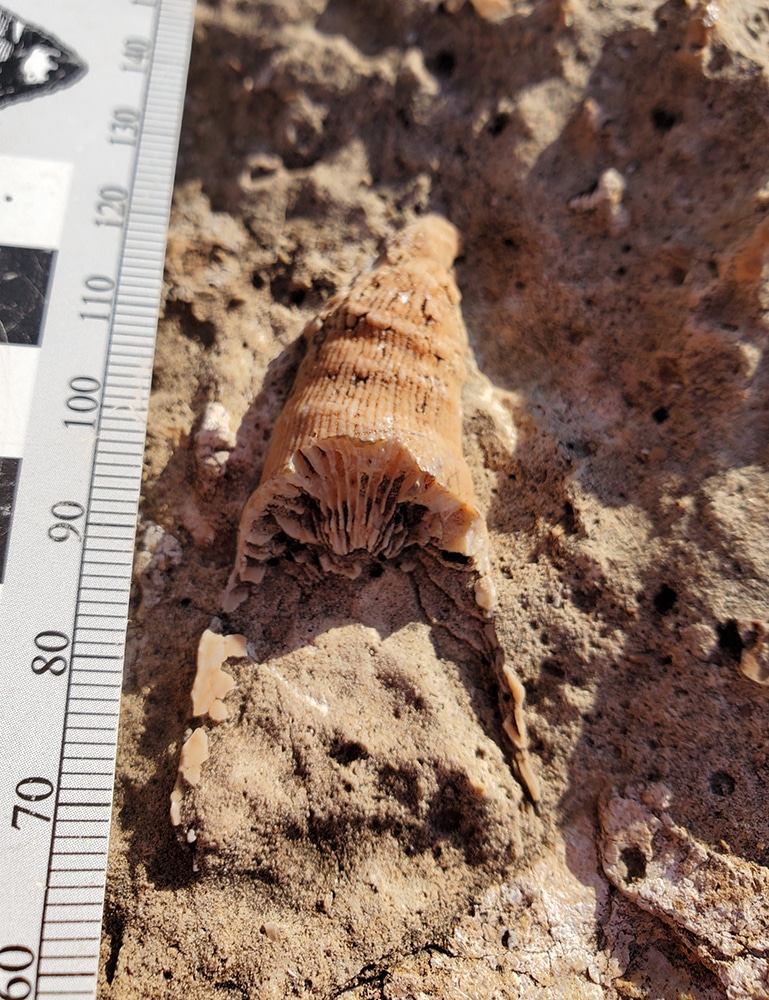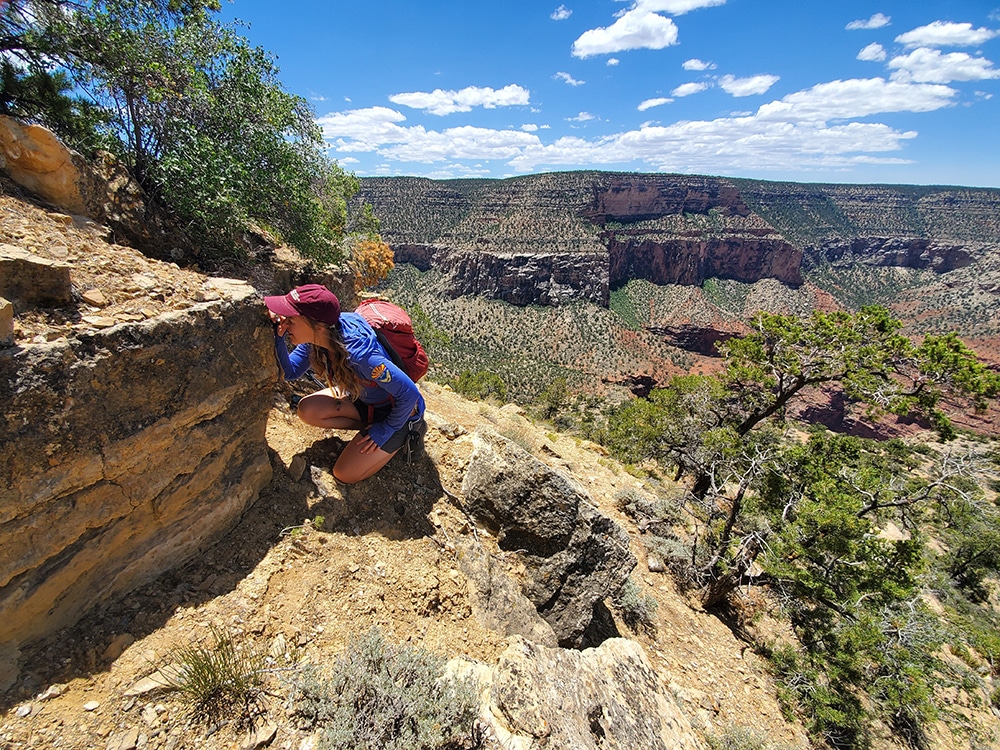By Anne Miller, NAU alumna, 2019
Miller received her bachelor’s degree in geology from Oklahoma State University in 2013, and her master’s in geology from Northern Arizona University in 2019. She now works as a geologist at Grand Canyon, where she manages paleontology and geology resources in the park. She also serves on the alumni board for the School of Earth and Sustainability at NAU.

There’s a certain awe and majesty that Grand Canyon emanates beyond its magnificent views. The first time I laid eyes on these rocks, it shocked me with curiosity and some frustration. How could I ever begin to comprehend this immense chasm of exposed geologic history?
We all know that it took a while for the Colorado River to cut down into Grand Canyon, but the layers of rock it has now exposed bring the story as far back as 1.8 billion years! These layers of rock represent little slices of ancient worlds throughout Earth’s history, from oceans to lush river deltas and desert sand dunes. Evidence for these ancient environments lie in the details of rock textures, structures, composition and of course, fossils. Investigating this in such a remote place like Grand Canyon has its challenges, but even learning a small piece of this ancient history can lend to a world of imagination. Now when I look across the canyon, I can become emersed in these incredible slices of deep time…
Looking toward the green slopes of the Tonto Platform, I begin to see the clear, shallow water and sandy shores of the Bright Angel Formation 500 million years ago, where life thrives in oceans and the land is barren. Migrating tidal channels and shifting sands create areas for marine organisms to thrive and adapt. I can see the slimy marine worms burrowing and hiding from giant swimming predators. Hard-shelled arthropods roam the seafloor, furrowing in the sediment with only their eyes exposed. Sea pens sway as the waves come in.
My eyes move up across the canyon toward a prominent limestone cliff, and I begin to see the ocean of the Redwall Formation 350 million years ago containing lively reefs and predators with monstrous tentacles that navigate the water column within their straight, cone-shaped shell.
Above those rocks, I see the broad coastal plain of the Hermit Formation 285 million years ago, a semi-arid land teeming with diverse plants, insects, reptiles and amphibians near the banks of slow-moving rivers. Giant millipedes move seamlessly across the land with their many legs searching for food. Sediment gently engulfs ancient horsetail plants as rivers flood. The broad leaves of fern-like plants provide shade to animals on those hot, sunny days. There are reptiles and amphibians of various sizes walking along muddy
High winds carry sand from hundreds of miles away and deposit it all here, filling in those mud cracks. The windblown sands of the Coconino Formation continue to build up, erode and shift again. I see the large, amphibian-like reptiles walking up a sand dune with their families, in search of prey. A giant, hairy spider looks for beetles to munch on.
As the sea level rises, I begin to see the beaches of the Toroweap turn into the lively seas of the Kaibab Formation 275 million years ago. In this ocean, I see the horn-shaped corals, the brachiopods, crinoids and sponges, all attached to the seafloor. Terrifying ratfish ancestors use their huge front teeth to tear the flesh of other fish. The monstrous, tentacled nautiloids swim faster and more efficiently in their more evolved, coil-shaped shell.

I can see the preserved shapes of conical nautiloids and coral impressions in the rock of the Redwall Formation. I can easily find plant impressions, footprints of amphibians and reptiles and burrows of insects in the Hermit Formation. There are many different tetrapod, spider and scorpion tracks all over the Coconino Sandstone, each trackway telling its own story. And finally, in the Kaibab Limestone at the rim, I see the preserved horn corals, the ossicles of a crinoid stalk, brachiopod shells and sponge impressions. I also find the strangest teeth of unimaginable prehistoric fish.
The pieces of the Grand Canyon’s immense geological history are written in its rocks. Not only is this a place to appreciate the beauty and diversity of our natural world, but it can also become a place to really connect with Earth’s geologic past. It’s hard not to walk away from Grand Canyon without a newfound respect for our planet and our place in this vast ocean of geologic time.



